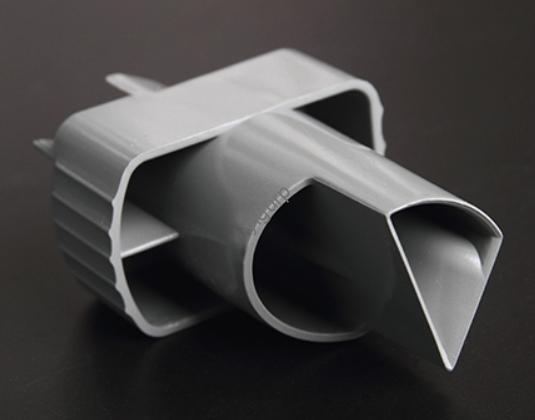If you’re a product designer or manufacturer looking to create accurate 3D printing handboards for new product development, L'une des premières questions que vous poserez est: “What materials should I use?” Choosing the right material directly affects your handboard’s durability, apparence, and whether it matches your final product’s performance. Let’s break down the most common 3D printing handboard materials, Leurs utilisations, and how to pick the best one for your project.
Common 3D Printing Handboard Materials & Their Key Details
To make it easy for you to compare, we’ve organized the top materials into a clear table. Each entry includes the material name, suitable 3D printing technology, main advantages, and typical handboard applications.
| Type de matériau | Suitable 3D Printing Technology | Avantages clés | Typical Handboard Applications | Average Cost (Par kg) |
| Plastiques d'ingénierie (ABS/PLA) | FDM (Modélisation des dépôts fusionnés) | Faible coût, facile à imprimer, Bonne résistance à l'impact (Abs) | Prototypes de produits de consommation (jouets, articles ménagers), structural test parts | \(20 – \)50 |
| Photopolymer Resins | Sla (Stéréolithmicromographie)/DLP (Traitement de la lumière numérique) | En détail, finition de surface lisse, haute précision | Prototypes de haute précision (electronic casings, modèles de bijoux), visual display handboards | \(80 – \)150 |
| Rubber-Like Materials | FDM / SLS (Frittage laser sélectif) | Flexible, élastique, good grip | Handboards for soft parts (poignées, joints, semelles à chaussures) | \(60 – \)120 |
| Matériaux métalliques (Titanium Alloy/Stainless Steel) | GDT (Maisse au laser sélective)/SLS | Forte résistance, résistance à la corrosion, résistance à la chaleur | Industrial part prototypes (composants automobiles, pièces aérospatiales), functional test handboards | \(300 – \)800 |
| Matériaux en céramique | SLA/SLS | Résistance à haute température, haute précision, attrait esthétique | Artistic handboards, dental implant models, high-temperature test parts | \(150 – \)300 |
| Matériaux composites (Carbon Fiber-Reinforced Plastic) | FDM / SLS | Léger, forte résistance, rigide | High-performance handboards (cadres de drones, sports equipment prototypes) | \(100 – \)250 |
| Matériaux alimentaires (Sugar/Chocolate) | Specialized Food 3D Printers | Edible, customizable shapes | Promotional handboards (food product samples, decorative cake toppers) | \(50 – \)100 |
| Gypsum Materials (Colored) | Jet de liant | Vibrant colors, Facile à façonner, faible coût | Visual display handboards (sculptures, modèles architecturaux) | \(30 – \)80 |
| Artificial Bone Powder | SLS/SLM | Biocompatible, matches bone structure | Medical handboards (orthopedic implant prototypes, guides chirurgicaux) | \(500 – \)1,200 |
How to Choose the Right Material for Your 3D Printing Handboard
Picking a material isn’t just about cost—it needs to fit your handboard’s purpose. Voici 4 key factors to consider, with simple questions to guide your decision:
1. What’s the Handboard’s Main Use?
- If it’s for visual display (Par exemple, showing a product’s design to clients), aller à résines photopolymères (surface lisse) ou colored gypsum (couleurs vibrantes).
- If it’s for tests fonctionnels (Par exemple, checking if a part can withstand pressure), choisir plastiques d'ingénierie (Abs) ou matériaux métalliques (forte résistance).
- If it’s for medical or biocompatible needs (Par exemple, orthopedic prototypes), artificial bone powder est le premier choix.
2. Quel est votre budget?
- Budget-friendly options (under $50/kg): PLA (a type of engineering plastic) and gypsum. Great for simple visual handboards.
- Mid-range options (\(50 – \)200/kilos): Abs, rubber-like materials, et matériaux composites. Balanced for most testing and display needs.
- High-end options (over $200/kg): Métaux (alliage en titane) and artificial bone powder. For industrial or medical-grade handboards.
3. Do You Need Special Properties?
- Flexibilité: Rubber-like materials are the only choice for handboards that need to bend (Par exemple, a prototype of a phone case with a soft edge).
- Résistance à la chaleur: Ceramic materials or stainless steel work best if your handboard will be exposed to high temperatures (Par exemple, a prototype of a kitchen appliance part).
- Léger & Force: Composite materials like carbon fiber-reinforced plastic are perfect for handboards that need to be strong but not heavy (Par exemple, a drone frame prototype).
Yigu Technology’s View on 3D Printing Handboard Materials
À la technologie Yigu, we believe that the right 3D printing handboard material is the bridge between design ideas and market-ready products. Based on our work with hundreds of manufacturing clients, plastiques d'ingénierie (ABS/PLA) et résines photopolymères are the most versatile choices for most new product 研发 (R.&D) projects—they balance cost, ease of printing, et les performances. For industrial clients needing high-strength handboards, we recommend carbon fiber composites or stainless steel, as they replicate the durability of final parts. We also see growing demand for biocompatible materials like artificial bone powder in medical R&D, and we’re committed to offering these options to support innovative healthcare solutions.
FAQ
T1: Can I use PLA for functional test handboards?
PLA is great for visual handboards, but it’s less durable than ABS. For light functional tests (Par exemple, checking fit), it works. But for tests involving impact or heat, ABS or metal is better.
T2: Are rubber-like materials suitable for long-term handboard use?
Rubber-like materials can degrade slightly over time (especially if exposed to sunlight), so they’re best for short-term handboards (Par exemple, 1-3 mois de tests). Pour une utilisation plus longue, consider adding a protective coating.
T3: How much does a metal 3D printing handboard cost compared to a plastic one?
En moyenne, a metal handboard costs 5-10 times more than a plastic one. Par exemple, a small plastic handboard (100g) might cost \(5-\)10, while a similar metal handboard could cost \(50-\)100. The exact price depends on the metal type (titanium is more expensive than stainless steel) and handboard size.
